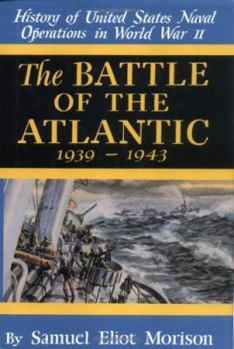The Battle of the Atlantic: September 1939-May 1943
(Book #1 in the History of United States Naval Operations in World War II Series)
Select Format
Select Condition 
Book Overview
This first volume explores all U. S. naval operations in the Atlantic, including the Caribbean, Gulf of Mexico, Barents Sea, and the defense of American shores and ships, with much attention given to... This description may be from another edition of this product.
Format:Hardcover
Language:English
ISBN:0785813020
ISBN13:9780785813026
Release Date:January 2001
Publisher:Castle Books
Length:434 Pages
Weight:1.82 lbs.
Dimensions:1.6" x 6.1" x 8.8"
Customer Reviews
2 ratings
An Example of Morison's High Standard of Scholarship
Published by Thriftbooks.com User , 22 years ago
Few people had such an opportunity to view the events of WWII at sea as did Samuel Eliot Morison. Since it was Morison's own idea, the credit must surely go to him as well as to FDR. The visit between Roosevelt and Morison which set the stage for Morison's role as the official WWII naval historian was probably not so much a meeting between a lofty president and a lowly Harvard professor as it was a friendly get-together between two fellow preppies and Harvard grads of approximately the same age. I have assumed that this bond did not unduly influence Morison's evaluation of FDR's performance as Commander-In-Chief.The introduction to THE BATTLE OF THE ATLANTIC 1939-1943 gives a good account of the state of U.S. Navy preparedness between the two World Wars. The appencices help the reader to appreciate the relative strength of the combatants. It is important to realize that the Navy was already making its weight felt in various parts of the world before the Japanese attack on Pearl Harbor. The United States Navy was forced into this situation by the rapidly evolving predicament of Great Britain and her allies. The Nazis had overrun Greece and Crete and had put Russia deep in a hole. It appeared possible that Germany and Italy would soon control all three entrances of the Mediterranean - The Straits, The Dardanelles and the Suez Canal. Much of this book describes in great detail how the tide of war turned from this low beginning to a much brighter picture for the Allies by April 1943. By then Germany had lost the strategic initiative when it failed to capture Stalingrad. The German Black Sea Fleet was fighting a losing battle and Germany was forced to evacuate its remaining troops from North Africa. In addition, the Allies were organizing an invasion of the European Continent while Japan was on the defensive in the Pacific.The story is a wide-ranging one because the area involved in the Battle of the Atlantic is so vast. At one end we have the supply run to North Russia to give that beleagured country the essential means to continue to fight. At the other end there is the important contribution of Brazil to the ultimate victory by the Allies. In between there is the very dangerous threat of the German submarine offensive and our paralyzingly slow response to it. The tragedy of our substantial merchant marine losses in the early part of hostilities is described in some detail by Morison but the explanation of exactly how this situation developed is one of the more disappointing aspects of the book. The responsibility for the calamity is still being debated and explored. Morison does not go much below the surface in his account of this sordid affair although the author is not necessarily an unqualified fan of Admiral Ernest J. King.THE BATTLE OF THE ATLANTIC 1939-1943 is a very detailed historical record in spite of the book's few shortcomings. My respect for Samuel Eliot Morison is increased by reading it and I highly recommend the volume to anyone int
Still definitive, this is Samuel Eliot Morison's masterpiece
Published by Thriftbooks.com User , 26 years ago
When the great narratives of World War II are collected in an archive for future generations, this should be the first set of books added to the library. Morison is one of the finest historical writers of all time and any book of his is worth reading. I have read 8 different volumes in this series and always feel that I am in the middle of each conflict (as well I should, since the author was there). I hope, when I retire, to acquire the entire 15-volume set and read it from cover to cover. It makes me hope for early retirement!!!






